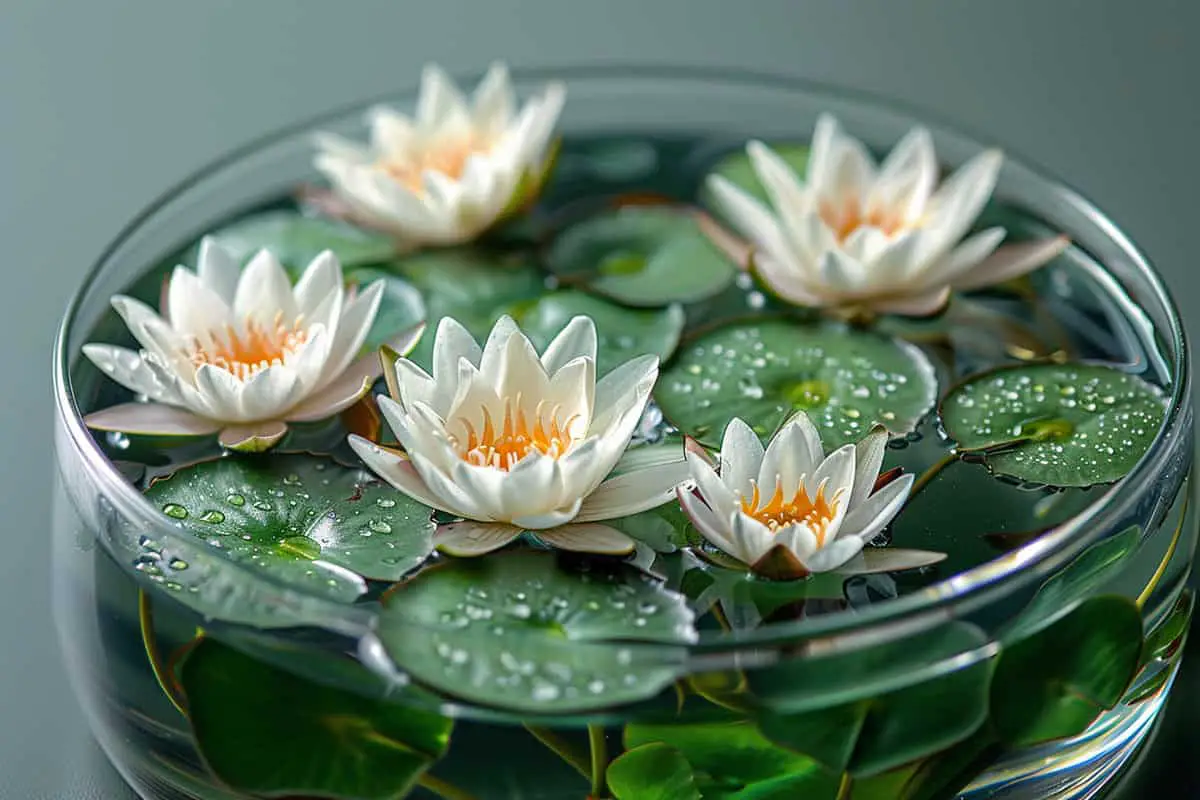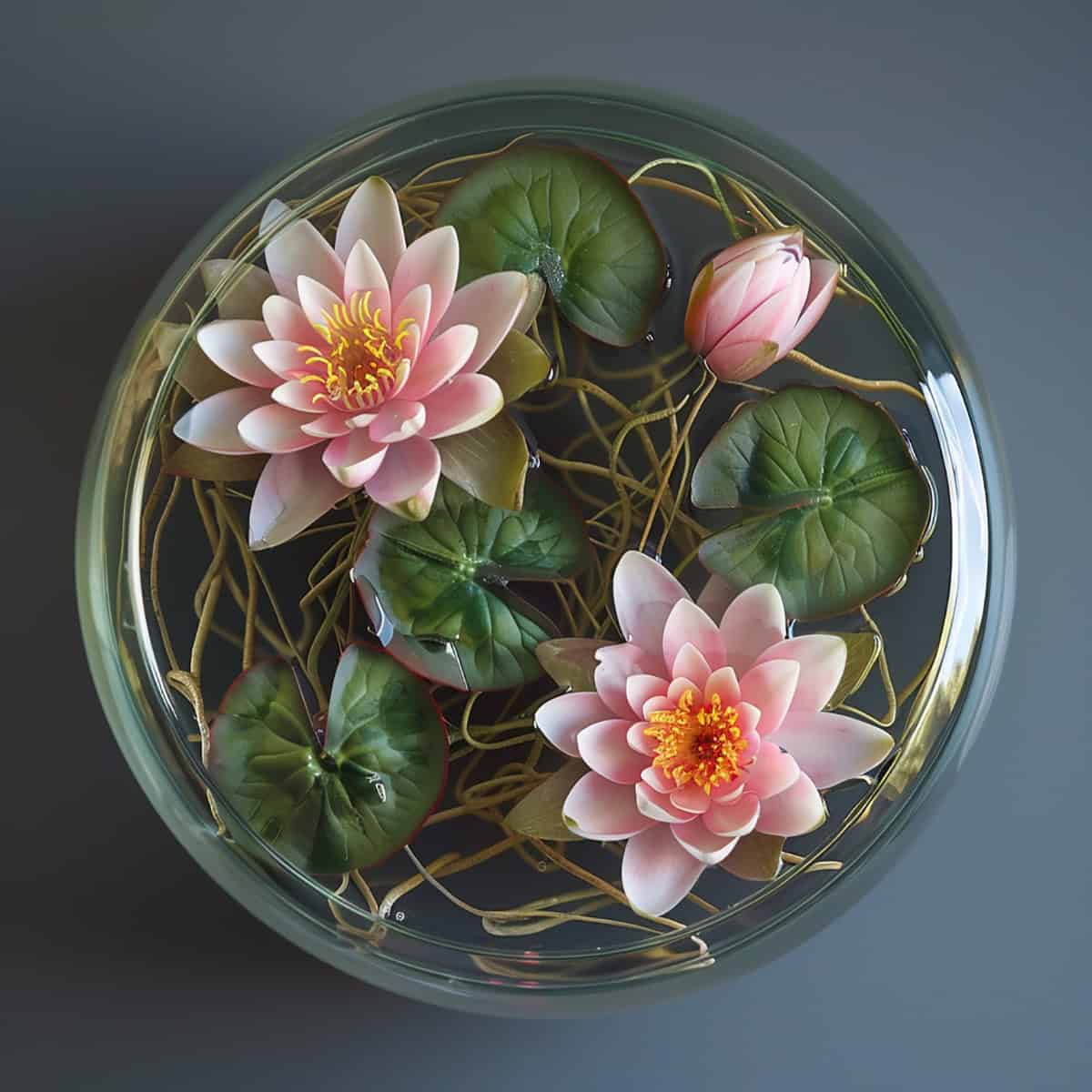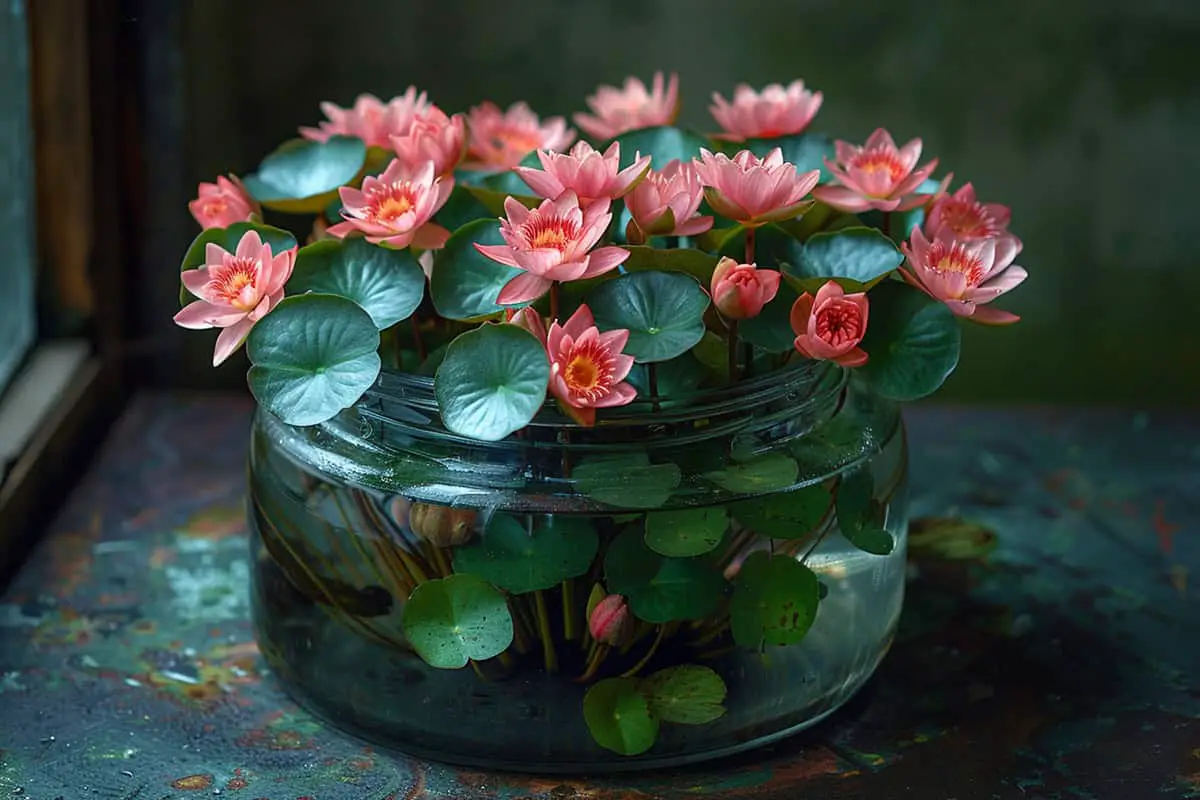You’ve just returned from a visit to a friend’s home, where you were captivated by the elegant water lilies blooming in clear glass vases on their windowsill. Inspired, you decide to try growing your own. Growing water lilies in glasses is not only visually stunning but also surprisingly simple. Follow these steps to create your own beautiful aquatic display, adding a unique and tranquil touch to your home decor.
Table of Contents
Choosing the Right Glassware
Selecting suitable glassware for growing water lilies impacts their growth and aesthetic appeal. This section provides detailed guidance on important considerations, including size, shape, material, and durability.
Size and Shape Considerations
Water lilies require specific dimensions to thrive. Glasses should be at least 12 inches deep to support long stems and root systems. Look for glasses with a broad base to ensure stability and prevent tipping.
A wide mouth facilitates easy planting and maintenance. It also allows ample sunlight to reach the plant, promoting healthy growth. Opt for cylindrical or bowl-shaped glasses, which mimic natural pond conditions, providing enough surface area for the lilies to spread.
Consider the space available in your indoor or outdoor area. Balance the aesthetic fit with the practical needs of your water lilies. The right size and shape will not only enhance plant health but also contribute to your decor.
Material and Durability
The glass used should be robust enough to handle the weight of soil, water, and the growing plant. High-quality tempered glass is a suitable option. It offers better resistance to cracking and breaking compared to regular glass.
Ensure the material is transparent to maximize light exposure. Transparency helps in monitoring water levels and plant health without disturbing the setup. Avoid glassware with coatings that may block light or chemicals that could leach into the water and harm the plants.
Durability is key, especially for outdoor settings. Consider glasses with thicker walls and sturdy construction. This helps in withstanding environmental factors such as wind and accidental impacts. Long-lasting glassware ensures that your water lilies can grow undisturbed for extended periods.
Water Preparation and Quality Control

Ensuring the water in which your water lilies grow is well-prepared and consistently monitored is key to their health. Focus on maintaining appropriate pH levels, essential nutrients, temperature, and light.
pH Levels and Nutrients
For optimal growth, water lilies require a pH level between 5.5 and 7.6. You can test the pH using a simple test kit. If the water is too acidic, add lime. For alkaline water, use sulfur-based treatments.
Essential nutrients are also crucial. Add aquatic plant fertilizer to the water. This should include a mix of nitrogen, phosphorus, and potassium. These nutrients support robust growth and vibrant flowers. Without them, your water lilies may not thrive.
Monitor the nutrient levels regularly. Over-fertilization can lead to algae, which competes with water lilies for nutrients. Ensure the water remains clear and balanced.
Temperature and Light
Ideal temperatures range from 70°F to 80°F. Avoid placing water lilies in locations where water temperatures drop below 60°F or rise above 85°F.
Light is another critical factor. Water lilies need at least six hours of direct sunlight daily. Place them in a spot that receives ample sunlight. Insufficient light can result in poor blooming and weak plants.
Additionally, ensure the water remains still. Water lilies grow best in calm water. Avoid turbulent conditions caused by waterfalls or fountains.
Planting the Water Lilies
Growing water lilies in glasses requires specific conditions for soil and root placement. This ensures healthy growth and vibrant blooms.
Soil and Substrate
Choose heavy clay soil for water lilies. This soil type is nutrient-rich and supports root development. Avoid light or sandy soils. They don’t provide enough stability.
Place the soil at the bottom of the glass. Fill it about one-third full. This creates a firm base for the roots. Adding a thin layer of gravel on top helps keep the soil in place. It also prevents cloudiness in the water.
Water lilies prefer still water. Select a glass that doesn’t have a fountain or strong water movement. This maintains ideal growing conditions.
Root Placement and Depth
Carefully handle water lily rhizomes. They are brittle and can break easily. Position the rhizome diagonally in the soil. The growing tip should face upward. This promotes proper growth.
Plant the rhizome about 2-3 inches deep. This provides stability and helps the plant establish. Keep the crown or growing point above the soil. This prevents rot and allows the plant to sprout.
Use a container with at least 3-4 inches of water above the soil. This depth is optimal for most water lily varieties. Check that the glass is deep enough for the plant’s mature size.
Care and Maintenance

To keep your water lilies thriving in glasses, focus on maintaining clean water and removing old or dying plant parts. Both of these practices are essential for promoting healthy blooms and preventing decay.
Water Change Schedule
Change the water in your glass container regularly to keep your water lilies healthy. Freshwater ensures the roots receive enough oxygen, and it prevents algae buildup. Replace about a third of the water every week. If you notice the water becoming cloudy or developing an odor, increase the frequency of water changes.
Do not use tap water that is chlorinated. Allow tap water to sit out for 24 hours before using it. This allows the chlorine to evaporate, making it safer for your water lilies.
Pruning and Deadheading
Pruning and deadheading your water lilies encourage new growth and keep them looking their best. Cut away any yellowed or dying leaves with clean scissors. This helps prevent decay and disease. Regularly remove spent flowers to encourage the plant to produce new blooms.
If you see small plantlets forming on the plant, consider removing and replanting them. This controls overcrowding and promotes a cleaner environment for your water lilies.
Pest and Disease Management
Pests and diseases can significantly impact the health and growth of water lilies. Proper management strategies are essential for maintaining vibrant and healthy plants.
Common Issues
Water lilies often face various pests such as aphids and spider mites. Aphids are small, soft-bodied insects that suck sap and weaken the plants. Meanwhile, spider mites are tiny, web-spinning pests that cause leaves to look speckled and discolored. Additionally, leaf miners can burrow into the leaves, creating unsightly trails.
Diseases can also affect water lilies, with root rot being a common problem. This fungal disease thrives in overly wet conditions and leads to rotting of the plant’s roots. Another frequent issue is Verticillium wilt, a soil-borne fungal disease that causes leaves to yellow and wilt quickly.
Treatment and Prevention
To manage pests such as aphids and spider mites, introduce natural predators like ladybugs and predatory mites. Using a mild insecticidal soap can also help control infestations without harming the plants. Regularly inspect plants and remove affected leaves to prevent the spread of pests.
For diseases like root rot, ensure proper water management. Avoid overwatering and ensure the planting containers have good drainage. If you notice signs of fungal infections, consider using fungicides specifically made for aquatic plants. Practicing good hygiene by removing dead plant material from the pond will also help prevent disease buildup.
Troubleshooting Common Problems
Yellow Leaves
Yellow leaves often indicate nutrient deficiencies. Check for signs of iron deficiency if the leaves turn yellow but the veins remain green. Add appropriate fertilizers to resolve this issue.
Wilted Flowers
Wilted flowers can result from inadequate sunlight or water. Ensure your water lily gets at least 6 hours of sunlight each day. Maintain proper water levels in the container to prevent dehydration.
Insect Infestations
Inspect your plants regularly for pests like aphids and spider mites. Removing insects by hand or using insecticidal soap can keep infestations under control. Use predatory insects for natural pest management when necessary.
Algae Growth
Algae can overtake water lilies if not managed. Reduce feeding frequency to prevent excess nutrients, and consider adding a small water filter. Ensure the water recirculates properly to discourage algae buildup.
Root Rot
Root rot occurs due to poor water quality or overwatering. Use a well-balanced aquatic plant soil to improve water drainage. Trim any brown or mushy roots to prevent further damage. Regularly replace the water in your container for healthier growth.






